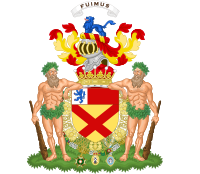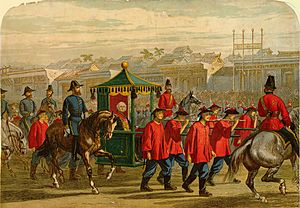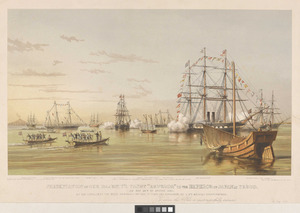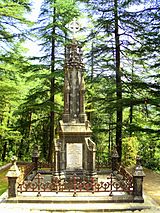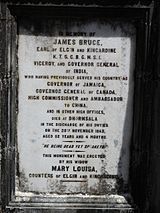James Bruce, 8th Earl of Elgin facts for kids
Quick facts for kids
The Earl of Elgin and Kincardine
|
|
|---|---|

The 8th Earl of Elgin, c. 1860
|
|
| Viceroy and Governor-General of India | |
| In office 21 March 1862 – 20 November 1863 |
|
| Monarch | Victoria |
| Preceded by | The Earl Canning |
| Succeeded by | Sir Robert Napier As Acting Governor-General |
| Governor General of the Province of Canada | |
| In office 1847–1854 |
|
| Monarch | Victoria |
| Preceded by | The Earl Cathcart |
| Succeeded by | Sir Edmund Walker Head |
| Governor of Jamaica | |
| In office 1842–1846 |
|
| Monarch | Victoria |
| Preceded by | Sir Charles Metcalfe |
| Succeeded by | George Berkeley As Acting Governor |
| Personal details | |
| Born | 20 July 1811 London, England |
| Died | 20 November 1863 (aged 52) Dharamshala, Punjab, British India |
| Spouses |
|
| Children | Victor Bruce, 9th Earl of Elgin |
| Parents | Thomas Bruce, 7th Earl of Elgin Elizabeth Oswald |
| Alma mater | Christ Church, Oxford |
| Signature | |
James Bruce, the 8th Earl of Elgin and 12th Earl of Kincardine (born July 20, 1811 – died November 20, 1863), was an important British leader. He worked as a colonial administrator and diplomat. He served in several key roles around the world. These included Governor of Jamaica, Governor General of Canada, and Viceroy of India. He also played a big part in opening up trade with China and Japan.
Contents
Early Life and Education
James Bruce was born in London, England, on July 20, 1811. His father was the 7th Earl of Elgin. His father was famous for bringing the Elgin Marbles to Britain. These are ancient Greek sculptures.
James had many brothers and sisters. He went to Eton College and Christ Church, Oxford. He studied Classics and did very well. At Oxford, he became good friends with William Ewart Gladstone, who later became a British Prime Minister.
A Career in Public Service
James Bruce became a Member of Parliament in 1841. However, his election was later cancelled. In November 1841, his father passed away. James then became the 8th Earl of Elgin. This meant he inherited his father's title.
Leading Jamaica
In 1842, James Bruce became the Governor of Jamaica. He held this position for four years. During his time, he worked to improve life for the Afro-Caribbean workers. He also worked well with the white planters. Everyone respected his leadership.
Governing Canada
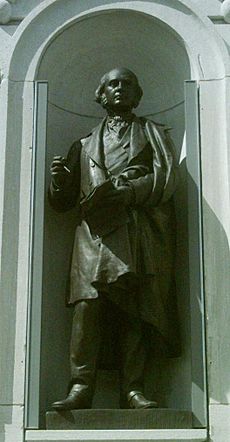
In 1847, Lord Elgin was chosen to be the Governor General of the Province of Canada. This was a very important role. He helped Canada move towards "responsible government." This meant that the local government would have more control.
Lord Elgin was the first Governor General to step back from daily lawmaking. This made the Governor General's role more symbolic. He also dealt with many immigrants coming to Canada. This was a big challenge at the time.
In 1849, a law called the Rebellion Losses Bill was passed. It aimed to pay French Canadians for losses during the 1837 rebellions. Lord Elgin approved the bill, even though some people strongly disagreed. This led to a mob burning the Parliament Building in Montreal. Lord Elgin was even attacked. But he stayed calm and let local police handle it.
Because of his good work, he was given a higher title. He became Baron Elgin in 1849. He also helped settle trade and fishing issues with the United States. In 1849, there was also a riot in Bytown (now Ottawa). It was about his planned visit. But support for the Crown's representative eventually won out.
In 1854, Lord Elgin signed the Canadian–American Reciprocity Treaty. This treaty helped boost Canada's economy. He also approved a law that ended the old land system in Quebec. After this, he stepped down as Governor General. Lord Elgin supported the Bagot Report of 1847. This report helped shape the Canadian Indian residential school system.
Missions to China and Japan
In 1857, Lord Elgin was sent to China and the Far East. His job was to help open up trade with Western countries. During the Second Opium War, he helped lead the attack on Canton (Guangzhou). He then signed the Treaty of Tientsin in 1858. This treaty ended the war.
However, fighting continued in 1859. Lord Elgin returned to China in 1860. On October 18, 1860, he ordered the destruction of the Old Summer Palace outside Beijing. This was in response to the capture and mistreatment of European and Indian prisoners. The Old Summer Palace was a beautiful complex of palaces and gardens. It held countless artworks and historical items. Its destruction was a huge loss of cultural heritage.
On October 24, 1860, Lord Elgin signed the Convention of Peking. This agreement gave part of the Kowloon Peninsula and Hong Kong to Britain forever. Lord Elgin himself had mixed feelings about forcing trade on China and Japan. He once wrote that he felt "ashamed" of his actions during the bombing of Canton.
Between his two trips to China, Lord Elgin visited Japan. In August 1858, he signed the Anglo-Japanese Treaty of Amity and Commerce. This treaty made trade easier between Britain and Japan. He also gave a modern steam yacht, the HMY Emperor, to the Japanese Emperor. This was a gift from Queen Victoria.
Viceroy of India
Soon after returning to England, Lord Elgin was chosen for another big role. He became the Viceroy of India in 1862. He was the first Viceroy directly chosen by the British Crown. He worked to keep peace and enforce treaties in India.
He used Peterhoff, Shimla as his official home in India. In 1863, he was on a difficult journey through the mountains. He died of a heart attack on November 20, 1863. He was buried in the churchyard of St. John in the Wilderness in Dharamshala.
Family Life
Lord Elgin married Elizabeth Mary Cumming-Bruce in 1841. Sadly, she passed away in 1843, shortly after their second daughter was born. They had two daughters, including:
- Lady Elma Bruce (1842–1923), who later married the 5th Baron Thurlow.
In 1846, Lord Elgin married Lady Mary Louisa Lambton. She was the daughter of the 1st Earl of Durham. They had four sons and one daughter:
- Victor Bruce, 9th Earl of Elgin (1849–1917)
- Hon. Robert Preston Bruce (1851–1893)
- Hon. Frederick John Bruce (1854–1920)
- Lady Louisa Elizabeth Bruce (1856–1902)
See also
- Anglo-Chinese relations
- Anglo-Japanese relations
Sources
- Narrative of the Earl of Elgin's Mission to China and Japan, 1857-8-9 (2 volumes), Laurence Oliphant, 1859 (reprinted by Oxford University Press, 1970) {No ISBN}
- "Moving Here, Staying Here:" The Canadian Immigrant Experience, Library and Archives Canada, A letter from Lord Elgin, Governor General of the Canadas, to the Colonial Office
Also digitized by Canadian Institute for Historical Microreproductions, 2003.


